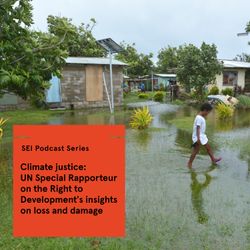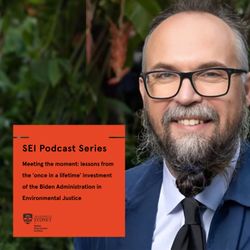Share

The SEI Podcast Series
Everybody Pitches In
Community-led actions are enabled through their ability to draw on local networks, skills and knowledges to respond swiftly and flexibly in times of crisis. This vignette describes how a family drew upon their ‘everyday’ networks around work, school, sports and their neighbourhood to organise response and recovery support across multiple floods.
‘Stories are the Toolkit’ is a vignette series that illuminates community-led action. The stories are based on interviews with 68 individuals who, in their different ways, contributed to community-led response, recovery and adaptation across three regions in New South Wales: the Northern Rivers, the Hawkesbury and the Blue Mountains.
Listeners are advised that this vignette mentions flooding and bushfire events. It may be distressing to some listeners, so please take care. If you need to talk to someone, please contact Lifeline on 13 11 14.
More episodes
View all episodes

UN Special Rapporteur on the Right to Development's insights on loss and damage
43:04|In this instalment of the SEI Podcast Series, UN Special Rapporteur on the Right to Development Professor Surya Deva unveils his Climate Justice: Loss and Damage report, just days after its presentation to the UN General Assembly. Professor Deva presents a climate justice framework with four pillars: mitigation, adaptation, remediation, and transformation, underpinned by 12 human rights principles. Professor Deva proposes a range of actions for states, international financial institutions, and businesses to address loss and damage. Timestamps: 00:49 - Welcome and introduction by Professor Rosemary Lyster06:39 - Professor Deva's introductory remarks07:00 - Discussion on climate justice frameworks30:59 - Professor David Schlosberg's response38:00 - How do we implement the framework?39:18 - Professor Deva responds42:30 - Closing commentsSpeakers: Professor Surya Deva, UN Special Rapporteur on the Right to Development Professor Rosemary Lyster, climate justice and disaster law researcher Professor David Schlosberg, Director of the Sydney Environment Institute
Meeting the moment: lessons from the 'once in a lifetime' investment of the Biden Administration in Environmental Justice
55:53|In this instalment of The SEI Podcast Series, renowned scholar Kyle Whyte will share his experiences serving the Biden administration, environmental justice organisations, and Tribal nations. In one of its earliest moves, the Biden Administration made a historic commitment to advancing environmental justice, significantly increasing federal programs, funding, and public awareness on the issue. This bold approach has been heralded as a "once in a lifetime" investment, creating new pathways for justice, equity, and environmental sustainability. But four years later, what has been the outcome? How have these expansive policies impacted the communities they were designed to serve? What are the successes, challenges, and ongoing barriers in this unprecedented investment?Timestamps00:50 - Introduction and welcome03:57 - Kyle's opening address30:52 - David and Kyle begin their discussion SpeakersProfessor Kyle Whyte, University of MichiganProfessor David Schlosberg, Sydney Environment Institute
Will putting a price on nature protect it?
56:36|In this instalment of The SEI Podcast Series, hear from experts from as they explore if valuing nature economically can lead to responsible environmental stewardship or if it undermines its innate value. Can we balance the financial valuation of nature with ethical stewardship, or do market mechanisms risk commodifying what is inherently invaluable?Timestamps:00:50 - Welcome and introduction6:22 - Are there are mechanisms to protect what’s left of our natural world?10:22 - What role do financial markets in driving positive environmental outcomes?18:06 - How can governments better regulate nature markets to ensure transparency and effectiveness?24:26 - How can the concept of nature markets align with Indigenous and community approaches?30:40 - Heading towards 2040, how do we see a price on nature contributing to the protection of the environment? 38:50 - Q+ASpeakers:Professor Carolyn Hogg, ChairAriadne Gorring, Pollination FoundationProfessor Dieter Hochuli, University of SydneyJoshua Bishop, environmental economistRadha Kuppalli, investment advisor
Natural solutions: seawalls are not the only climate buffer
47:12|In this instalment of The SEI Podcast Series, hear from experts as they explore the potential of nature-based solutions, like wetlands and mangroves, in acting as climate buffer infrastructure. They will share new findings from SEI’s project Examining climate buffer projects in the Philippines and feature other case studies from Australia and the Pacific, that address how justice and biodiversity issues can be addressed alongside climate adaptation solutions. Timestamps:00:51 - Welcome and introductions05:22 - How do mangroves function as a climate buffer?09:06 - The effectiveness of nature-based solutions compared with traditional engineering solutions13:00 - The importance of Indigenous and local knowledges on informing the design and implementation of nature-based solutions 17:45 - Overview of the Blue Heart Sunshine Coast Project and how project ownership and responsibility is shared with the local communities24:48 - How do we envision nature-based solutions transforming cities and rural landscapes to enhance climate resilience and biodiversity in the years ahead?33:54 - Q+A section46:03 - ConclusionSpeakers:Dr Justin See, Sydney Environment InstituteJazmin (Minet) Aguisanda-Jerusalem, Filipino disaster risk reduction expertDr Anneke van den Brink, marine ecologist and expert of nature-based solutions for coastal defenceDr Sonia Marshall, managing an adaptive floodplain management projectSuliasi Vunibola, researcher on Indigenous community resilience in the Pacific
Grassroots Resilience
13:08|Experiencing a disaster is often the catalyst for communities to realise the importance of being prepared, particularly when people have been forced to rely on each other in the absence of outside help. This vignette highlights how some local communities have since formed grassroots resilience groups to ensure that recovery, climate adaptation and preparation for future disasters occurs at the local community level. ‘Stories are the Toolkit’ is a vignette series that illuminates community-led action. The stories are based on interviews with 68 individuals who, in their different ways, contributed to community-led response, recovery and adaptation across three regions in New South Wales: the Northern Rivers, the Hawkesbury and the Blue Mountains. Listeners are advised that this vignette describes the aftermath of catastrophic flooding. It may be distressing to some listeners, so please take care. If you need to talk to someone, please contact Lifeline on 13 11 14.
Six Months On
11:57|During and after disasters, social media platforms become critical communication tools that enable the sharing of information, linking of donations and volunteers with those who need assistance, and help local groups to coordinate recovery activities. This vignette highlights how social media can aid small or remote communities who find themselves beyond the reach of government, emergency management and social service agencies and in need of external support to bring in what is needed. ‘Stories are the Toolkit’ is a vignette series that illuminates community-led action. The stories are based on interviews with 68 individuals who, in their different ways, contributed to community-led response, recovery and adaptation across three regions in New South Wales: the Northern Rivers, the Hawkesbury and the Blue Mountains. Listeners are advised that this vignette describes flood-affected homes and communities. It may be distressing to some listeners, so please take care. If you need to talk to someone, please contact Lifeline on 13 11 14.
Know Your Neighbours
14:16|Disaster-affected communities frequently emphasise the need to ‘know your neighbours’ – know who they are, what their needs and plans may be and what skills and resources they have. This vignette demonstrates how for some communities this takes the form of warden or street facilitator networks; people who understand the lay of the land, can serve as a point of contact for advice and organise street-level disaster preparation and readiness activities.‘Stories are the Toolkit’ is a vignette series that illuminates community-led action. The stories are based on interviews with 68 individuals who, in their different ways, contributed to community-led response, recovery and adaptation across three regions in New South Wales: the Northern Rivers, the Hawkesbury and the Blue Mountains. Listeners are advised that this vignette mentions bushfire events and describes the lead-up to the 2019-20 bushfire crisis. It may be distressing to some listeners, so please take care. If you need to talk to someone, please contact Lifeline on 13 11 14.
Coordinating the Boats
11:22|Flood-affected communities do not remain idle when the need is urgent. This vignette covers one way in which community members organised a system of tracking and coordinating boat rescues to save lives and to minimise the substantial risk taken by those on the water. ‘Stories are the Toolkit’ is a vignette series that illuminates community-led action. The stories are based on interviews with 68 individuals who, in their different ways, contributed to community-led response, recovery and adaptation across three regions in New South Wales: the Northern Rivers, the Hawkesbury and the Blue Mountains. Listeners are advised that this vignette describes people stranded on their roofs due to rising floodwaters. It may be distressing to some listeners, so please take care. If you need to talk to someone, please contact Lifeline on 13 11 14.